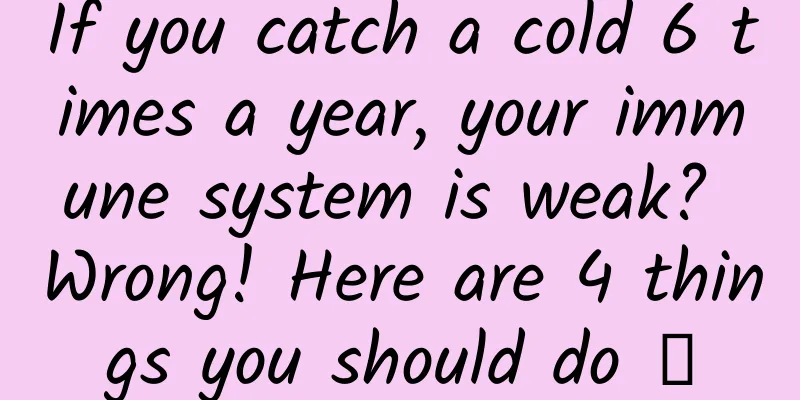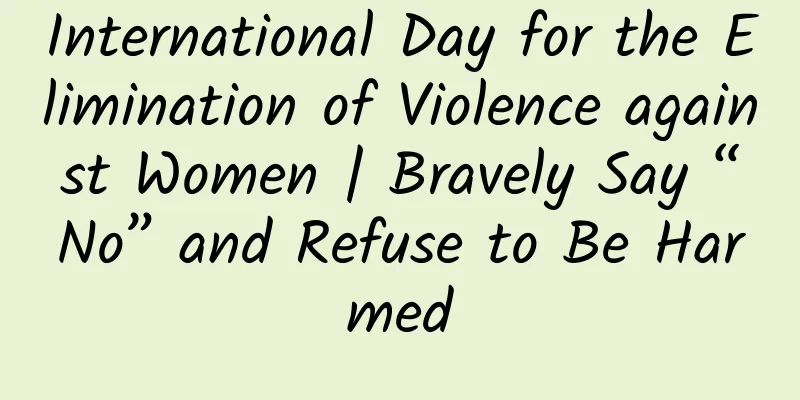If you catch a cold 6 times a year, your immune system is weak? Wrong! Here are 4 things you should do →

|
Many parents are always worried about why their children often catch colds and whether their children have problems with their immunity. In addition, various "random explanations" on the Internet about children's infectious diseases have also caused some parents to have serious anxiety, and even began to doubt that vaccination is ineffective. Some parents also believe that children should be prevented from being infected with any virus. Copyright images in the gallery. Reprinting and using them may lead to copyright disputes. So, does vaccination work for children? How many times do children get infected every year? What situations should we worry about? And what should parents really do? I hope everyone can take a closer look at this article today. Is it useful to vaccinate children? First of all, protecting children is the duty of parents, and humans will use various methods to prevent children from getting sick. The most important shield is the child’s own immune system . In a person's life, maternal antibodies are the only antibodies that come from another person - they are a gift from her life instinct. Copyright images in the gallery. Reprinting and using them may lead to copyright disputes. Maternal antibodies will protect the baby until 6 months after birth, and the level of these antibodies will decrease over time . From this transition period, the baby will have to face this world full of pathogens on his own. Their immune system is not fully developed. The level of immunity to some specific pathogens will not be fully developed until a few years later (or even until adolescence), such as immunity to pneumococcus. This is the importance of vaccination. Our country currently has more than a dozen vaccines in the childhood immunization program, which help children induce specific immunity without infection, including antibody response and T cell response. The figure below shows the changes in the incidence of childhood infectious diseases in China from 1949 to 2016. The number of cases of some infectious diseases has decreased by more than 99%, and the most important role played by large-scale vaccination is. Control of vaccine-preventable diseases in China from 1949 to 2016. Data source: Reference [1] However, the number of vaccines is limited after all. In fact, if you carefully look at your child's vaccination book, including both free and paid vaccines, you will find that the vaccines that can prevent viral respiratory infections are actually very limited. There are almost only two types of vaccines: the new crown vaccine and the influenza vaccine. The respiratory syncytial virus vaccine was only approved in May this year, and these vaccines are not very protective in preventing infection (compared to vaccines for viruses such as polio and measles). The vast majority (>99%) of viral respiratory infections cannot be prevented by vaccination, which means that children are frequently attacked by these viruses in the first few years of their lives . How many times a year do children get infected with viruses? So how do we know which virus a child is infected with? One way is that they may feel uncomfortable after being infected, and we take them to the hospital for laboratory testing (such as nucleic acid testing or antigen testing), but this method can only detect a limited number of cases because most children with mild symptoms do not go to the hospital; another method is mainly used for scientific research, which is to confirm the infection of a certain virus and the infection rate in the population through serological antibodies, which is relatively accurate. The number of infections children have each year may exceed your imagination . Infants and young children have an average of 6 to 8 viral respiratory infections each year. The main viruses include rhinovirus, influenza virus, parainfluenza virus, respiratory syncytial virus (RSV), coronavirus and certain adenoviruses , some of which cause upper respiratory tract infections (symptoms mainly appear in the nose and throat), some cause lower respiratory tract infections (symptoms mainly appear in the trachea, bronchi and lungs), but sometimes both may occur. Some children may be sick more often, with up to 12 cold symptoms per year, and children's symptoms usually last longer than adults, up to two weeks and coughs up to six weeks . Copyright images in the gallery. Reprinting and using them may lead to copyright disputes. These are passively reported symptomatic infections. According to some active monitoring, children are exposed to the virus for longer periods of time each year. In 2015, a study was published in Clinical Infectious Diseases. Researchers conducted regular nasal swab monitoring of the population and found that children under the age of 5 tested positive for respiratory viruses 50% of the time (even higher in multi-child families). Positive tests for bocavirus and rhinovirus usually had no symptoms, while positive tests for coronavirus, human metapneumovirus (HMPV) and influenza A usually had symptoms. 4 types of viruses that children are often infected with Here we pick a few typical respiratory viruses to talk about: 1. Coronavirus is a virus that everyone may be familiar with. The one that everyone hears the most now should be the new coronavirus (SARS-CoV-2), but coronavirus is actually a large family. About one-fifth of the common cold is caused by human coronavirus infection, and the most common ones are 229E and HKU1; 2. Rhinovirus is the most common cause of respiratory tract infection in children worldwide, causing more than half of the common cold . There are hundreds of serotypes of this virus, and there is almost no cross-protection between different serotypes. Although most children have mild symptoms after infection, some children will develop acute otitis media, sinusitis, or lower respiratory tract infection (croup and pneumonia) after infection, and increase the long-term risk of other diseases, such as asthma; 3. Human metapneumovirus (HMPV) is a virus that has been on the hot search several times recently (it is the virus with the rumor that "the mortality rate is 43% 100 days after infection"), but most children have actually experienced HMPV infection, and more than 90% of children over 5 years old can be detected with HMPV antibodies . According to a report by the American Pulmonary Association, HMPV usually causes symptoms of the common cold in children, and the symptoms last for 2 to 5 days. The number of HMPV cases each year is difficult to estimate because most children with mild to moderate symptoms do not go to the hospital for testing, but a small number (about 10%) of children will develop pneumonia after being infected with HMPV; 4. Respiratory syncytial virus (RSV) has clinical symptoms similar to HMPV. According to data from the US CDC, almost all (97%) infants will be infected with RSV at least once before the age of two. Most infants and young children will have symptoms similar to the common cold after being infected with RSV, but some will develop bronchiolitis or pneumonia, and 2% to 3% of all infants have been hospitalized due to RSV. Not only in the United States, RSV is also the main virus that causes acute lower respiratory tract infections in Chinese young children. More than 35 million children are infected with RSV each year worldwide, and repeated infections can occur, resulting in more than 3 million hospitalizations and nearly 60,000 deaths each year. Copyright images in the gallery. Reprinting and using them may lead to copyright disputes. The reason why infants and young children are at high risk of severe illness is, on the one hand, related to the physiological and anatomical structure of their respiratory system (for example , the trachea and bronchial lumens are relatively narrow, mucus secretion is small, and ciliary movement is poor, making it difficult to remove microorganisms or foreign bodies ). But more importantly, they have never been infected with this type of virus before and lack any specific immunity in their bodies. This is why most older children and young people have milder symptoms after being infected with RSV . It is not because the RSV strain they are infected with is less virulent, but because they were commonly infected when they were young and have developed specific immunity. Although many people will be reinfected with RSV (the prevalence of all exposed people is about 40%), antibodies can still reduce the risk of severe illness. Therefore, except for a few viral respiratory infections that can be prevented by vaccines, most viruses are unpreventable . Young children can only face these respiratory viruses, and then their immune systems gradually mature in the process of frequent contact with viruses . From a public health perspective, children's personal protection is also very poor - they touch everything in the nursery or kindergarten, often put their hands in their mouths (children aged 3 to 6 years old touch their hands and mouths 10 times an hour on average), do not cover their mouths and noses when they sneeze, do not know how to wash their hands seriously, and play happily with friends who are constantly coughing or blowing their noses. Copyright images in the gallery. Reprinting and using them may lead to copyright disputes. But there's nothing we can do about it. That's the nature of children. That's why children get a lot of colds every year. But for most children, frequent colds or typical respiratory symptoms do not mean they have immune deficiencies or other problems. Parents should pay attention if their children have these symptoms! So what are the situations in children that parents may really need to pay attention to? Here I quote the viewpoint of a popular science article from the Mayo Clinic. The dangerous signals that parents need to pay attention to are: -The child needs to be hospitalized after each illness; - Often requires intravenous antibiotics to get better; - Infections in less common sites (such as the liver or spleen); -8 or more ear infections in 1 year; - 2 or more severe sinus infections in 1 year - Little to no improvement with 2 months or more of antibiotic therapy; - 2 or more episodes of pneumonia within 1 year; - Recurrent deep skin or organ abscesses; -Persistent thrush in the mouth or elsewhere after 1 year of age; - Family history of primary immunodeficiency disease. Children with truly severe immunodeficiency are prone to repeated serious infections, or infections with pathogens that are less common in healthy children, which we call opportunistic pathogens, such as some fungi (Aspergillus, Pneumocystis jiroveci, and Cryptococcus, etc.). But other than that, parents may see an average of 6-8 respiratory viral infections in infants and toddlers each year . For children in daycare or just starting school, this number may be higher, but these children still have very normal immune systems. After experiencing attacks from a variety of common viruses, their immune systems will still respond promptly and efficiently to new infections in the future . To protect your children, parents are advised to do the following: There are a large number of viruses and bacteria in the world. A few viruses can be vaccinated to reduce the risk, but most cannot. There is also a lack of specific antiviral treatment drugs (either the effect is not clear, or there are concerns about side effects, or the price is too expensive). Young children will have many viral respiratory infections every year, and the main treatment after infection is symptomatic. Many viruses are not a big threat to healthy adults, mainly because we have almost all been infected once (or several times) when we were young. The prevalence of viral respiratory infections does not mean that we should choose to actively get infected. If parents really want to protect their children, they should do the following: Cultivate good hygiene habits in children This is the easiest thing that requires the most patience from parents. Children need to repeat it dozens or hundreds of times before they can slowly learn to wash their hands correctly (see the picture below). The same goes for covering their mouths and noses when sneezing/coughing, wearing masks in crowded places, etc. These measures cannot make children achieve zero infection, but they can help them reduce the number of times they get sick each year. Image source: Chinese Center for Disease Control and Prevention Note that these measures are not required for all children. For example, the simplest one is wearing a mask. According to the "Expert Consensus on Non-drug Interventions for Respiratory Viral Infections in Children" just released by the Chinese Medical Association this month, it is not recommended for children under 3 years old to wear masks. Parents can make judgments based on the actual situation of their children. There is no need to worry if young children are unwilling to wear masks. Vaccination Vaccines are not a panacea, but they can reduce the risk of infection and severe illness from many diseases. My daughter has received all the first-class vaccines and almost all the second-class vaccines available for her age. About two-thirds of respiratory infections in children are caused by viruses, but vaccines not only prevent viral diseases, but also 13-valent pneumococcal vaccines can prevent multiple types of pneumococcal bacteria and reduce the risk of ear, sinus and lung infections in children. Guardians must also take precautions It is not just the children who need to take proper precautions. As parents, we also need to take appropriate precautions, because some viruses are transmitted from parents to children (especially before the child is 3 years old) . For example, common "cold" symptoms experienced by parents may be RSV, which is a higher risk for infants under 6 months old and premature infants. In addition, women who receive vaccinations (including influenza vaccines and COVID-19 vaccines) during pregnancy can not only protect themselves, but also provide certain protection for the baby from birth to the time before vaccination through maternal antibodies. Parents should quit smoking Another important but often overlooked point in preventing viral respiratory infections in children is that parents should quit smoking, or at least not smoke in front of their children, because passive smoking increases the risk of severe lower respiratory tract infections and asthma in children . Pediatric respiratory infectious diseases involve complex knowledge from many different disciplines, and are also the most common problems for parents. There are many different opinions online. When your child encounters related problems, you can listen to the opinions of professional pediatricians and refer to the guidelines or suggestions issued by authoritative organizations, such as the expert consensus issued by the Chinese Medical Association mentioned above. Finally, I wish your child a healthy growth. References [1] Vaccine-preventablediseasecontrol in the People's Republic of China: 1949-2016 Author: Zhuang Shili and medical science blogger Reviewer: Tang Qin, Director and Researcher of the Science Popularization Department of the Chinese Medical Association |
<<: The stone actually grew hair? The truth is more terrifying than you think...
>>: [Popular Science] Why are many quadruped robots designed to look like dogs?
Recommend
Sex robots: Love me or them?
Currently, there is only one real sex robot you ca...
What are the channels for publishing articles for free in soft-text marketing?
Soft content marketing is the most common and eff...
How much does it cost to customize the Zhuzhou Electrician Mini Program? What is the price of customizing Zhuzhou Electrician Mini Program?
There is no fixed price for the customization of ...
Event Promotion Skills SOP
Today I would like to share with you my experienc...
Open and Create the Future BYD Global Developers Conference was grandly held
September 5, 2018 is destined to be recorded in t...
Is the Vernal Equinox the Earth’s exclusive right?
Xinhua News Agency, Tianjin, March 19 (Reporter Z...
Lightyear: You really misunderstood me!
What exactly is a light year? Because of the &quo...
Go to the Xisha Islands to see the sea? No, go to see the soil!
“After returning from Xisha, I didn’t look at the...
QuestMobile: AI large model applications will grow rapidly in 2024, DeepSeek's monthly active users will reach 180 million
With the continuous upgrading of AI big models, d...
my country lacks 4K TV standards: low-cost panels flood the market
As early as 2014, the China Household Electrical ...
Wu Yong's "Basic Training of Primary School Writing" Special Teacher's Primary School Writing Teaching
Training course content: The course starts with t...
The Light of Creation: What insights does the past, present and future of light bring us?
Light is so common and yet so special. It is ever...
In 2023, Apple paid TSMC $17.52 billion, accounting for 25% of TSMC's total revenue.
Recently, according to media reports, in 2023, Ap...
91 Ten Articles: Jidu invests 50 billion yuan in car manufacturing, and my country may mass-produce L5 autonomous driving vehicles by 2030
1. Jidu Auto, the electric vehicle joint venture ...
Fake traffic in channels is rampant---How can operators develop a keen eye?
In 2017, the mobile Internet was a turbulent sea....









